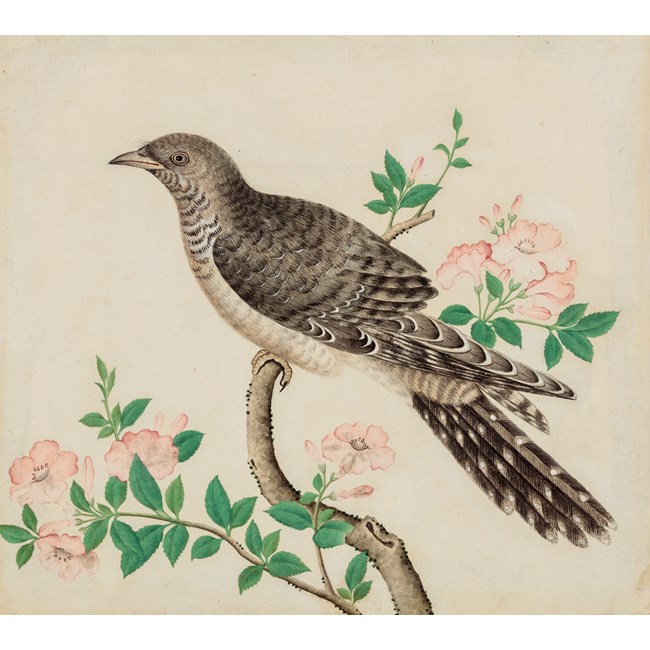
A study of an Indian Cuckoo (Cuculus micropterus)
A study of an Indian Cuckoo (Cuculus micropterus)
Probably Canton or Macau, China, 19th century
Pen and ink and watercolour with gum Arabic heightened with bodycolour.
26.5cm high, 30cm wide
Provenance: North American private collection
Stock: A5130
A study of an Indian Cuckoo (Cuculus micropterus)
An Indian cuckoo perches on the branch of a rose bush amongst a profusion of delicate pink flowers. Gracefully poised in profile, the bird’s feathers appear to their most resplendent capacity. Dynamic strokes of dark brown over greyish hues add texture and three-dimensionality to the plumage, while milky-whites crown the outer wings. Fine black chevrons punctuated with white dots ornament the tail feathers in a strikingly elegant camouflage.
The luscious display of emeralds and pinks surrounding the cuckoo reveals the artist’s delight in capturing the floral element of the composition. The serrated leaves burst forth as new growth is indicated by lighter green tones. Meandering stems terminate in languorous undulations of petals, whose deep pink edges gently fade to whitish hues. This intoxicating depiction encapsulating the vitality of the rose indicates an artist possessing an advanced understanding of the botanical arts.
First published in 1697, The Mustard Seed Garden Manual of Painting influenced generations of Chinese artists. It noted that “Flowers should carry themselves lightly…They should be drawn with liveliness, accurate colour, in appropriate circumstances, placed properly, and with buds added.” Due to its extensive flowering season, the rose was celebrated in China as ‘the eternal spring flower’ (changchunha) and was frequently painted.
In 1700s the East India Company established its first factory in Canton. Visiting botanists collected specimens from the Fa Tee (‘Flowery Land’) nurseries and commissioned experienced Chinese artists to paint them. In 1797 Lord Macartney returned from China with the ‘Macartney Rose,’ inspiring such adulation for the species that the Dog-rose became celebrated as England’s national flower.
Further Literature:
G.G. Khim. 1999. The William Farquhar Collection of Natural History Drawings. Singapore Goh: Geok Khim.
Judith Magee. 2013. Chinese Art and the Reeves Collection. London: Natural History Museum.
@AMIRMOHTASHEMI





 instagram
instagram
